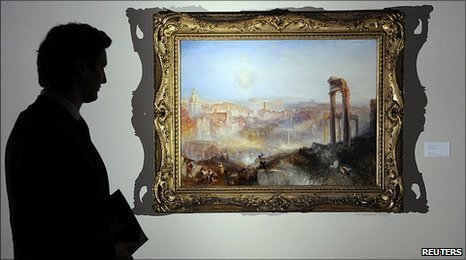On 12 Jan, 2011 With
Art Terms: Grisaille Grisaille is a term for painting executed entirely in monochrome or near-monochrome, usually in shades of grey. It is particularly used in large decorative schemes in imitation of sculpture. Many grisailles in fact include a slightly wider colour range, like the Andrea del Sarto fresco illustrated. Paintings executed in brown are sometimes referred to by the more specific term brunaille, and paintings executed in green are sometimes called verdaille. A grisaille may be executed for its own sake, as underpainting for an oil painting (in preparation for glazing layers of colour over it), or as a model for an engraver to work from. “Rubens and his school sometimes use monochrome techniques in sketching compositions for engravers.” Full…
Read More
On 4 Nov, 2010 With
Massacre of the Innocents (1611) by Peter Paul Rubens. Massacre of the Innocents (1611) by Peter Paul Rubens. Sold for £49.5m in 2002, at Sotheby’s, London. This work by the Flemish Baroque artist is the most expensive painting by an Old Master.
Read More
On 28 Oct, 2010 With
The number of visitors, 3.000 people, who have visited Palazzo Cini and seen Kitsch Biennale 2010 during the first 20 days bear witness of the public appreciation and its success. The Kitsch Biennale is an international exhibition for figurative and narrative painting. This year, the jury consisted of Bjørn Li (The Nerdrum Institute) and the kitsch painters Odd Nerdrum, Helene Knoop, Jan-Ove Tuv and David Dalla Venezia. They have focused on applicants displaying the serious and earnest expression. This sets the exhibition concept apart from the general trend of contemporary figurative painting. Works with an eternal outlook have been preferred.
Read More
On 13 Oct, 2010 With
An 1839 Turner masterpiece of a view of Rome has sold for £29.7m in London, breaking the artist’s auction record. Modern Rome – Campo Vaccino sold in five minutes with six bidders battling for the work which has only come up for sale once before, Sotheby’s said. The previous record was the £20.5m paid in 2006 for Venice painting Giudecca, La Donna della Salute and San Giorgio. Modern Rome, which had an estimate of £12m-£18m, was the top seller at the Old Master and British Paintings sale. Other highlights included Dutch artist Jan Lievens’ study of the head and shoulders of an old bearded man wearing a cap (circa 1629), which brought £2.5m against an estimate of £2-3m. TURNER AUCTIONS:…
Read More
On 9 Sep, 2010 With
‘I mean by a picture, a beautiful romantic dream of something that never was, never will be, in a light better than any light that ever shone, in a land no one can define or remember — only desire.” Sir Edward Burne-Jones’ home – The Grange “Nothing (with one small but important exception) remains of The Grange, where the Burne·Jones family lived for more than thirty years. It was in North End, Fulham, and consisted, from the eighteenth century on, of two red brick houses, standing back a little from the road, with iron gates and a short flagged path. Samuel Richardson had lived there from 1738 to 1754, (when his rent was put up to £40 p.a.), but there…
Read More
On 9 Sep, 2010 With
For many years The Virgin and Child with an Angel was prized as Francesco Francia’s earliest known dated painting (faintly signed and dated 1490) and for representing, in the chalice held by the angel, the only known example of the type of object Francia may have produced during his presumed earlier career as a goldsmith. But in 1954 an apparently identical version surfaced in a London auction. A thorough investigation of both paintings was undertaken to determine which was Francia’s original. Side-by-side investigation In 1955 examination of the National Gallery painting found the wood panel,ground and paint layers to be reasonably consistent with 15th-century practice, although it was noted that the gessoground was a remarkably bright white. The imprimatura was a pinkish-brown. Although most unusual…
Read More
On 7 Sep, 2010 With
When this painting first appeared around 1930, it was praised as a work byBotticelli. Not long afterwards, however, the investigations of art historians and scientists revealed it to be an outright fake, made with the intention to deceive. Acquisition The noted art collector Lord Lee of Fareham bought the Madonna of the Veil in 1930 from an Italian dealer for the sum of $25,000. He subsequently bequeathed it to The Courtauld Gallery, London in 1947. Despite a lack of information about its origins, the picture was universally hailed by connoisseurs and academics as a masterpiece by Botticelli when it first arrived in London in the early 1930s. The directors of the Medici Society published the painting as a ‘superb composition of the greatest of…
Read More
On 29 Jun, 2010 With
A look at the colours the Old Master Leonardo da Vinci used in his paintings. By Marion Boddy-Evans, About.com We may never know who the Mona Lisa was or what she’s smiling about, but we do have some idea of how Leonardo da Vinci created the sombre mood and smoky colors that add to her allure. Leonardo would first create a detailed underpainting in a neutral gray or brown, then apply his colors in transparent glazes on top. Some of the underpainting would show through the layers, subtly helping to create form. On his palette were muted, earthy browns, greens, and blues within a narrow tonal range. This helped give a sense of unity to the elements in the painting. No intense colors…
Read More



